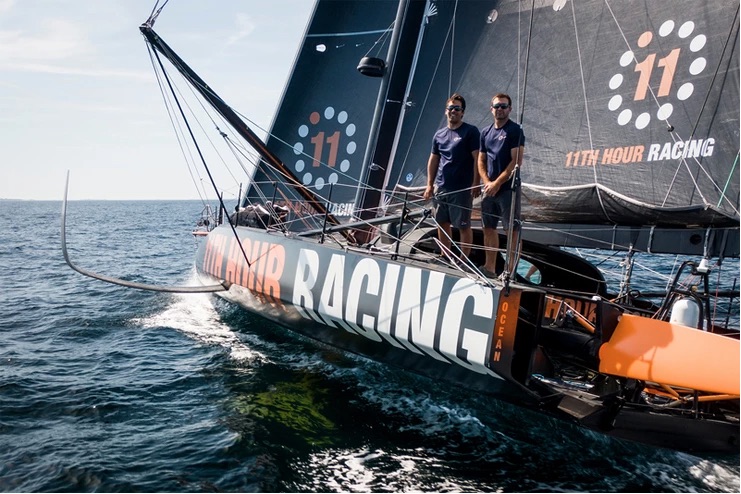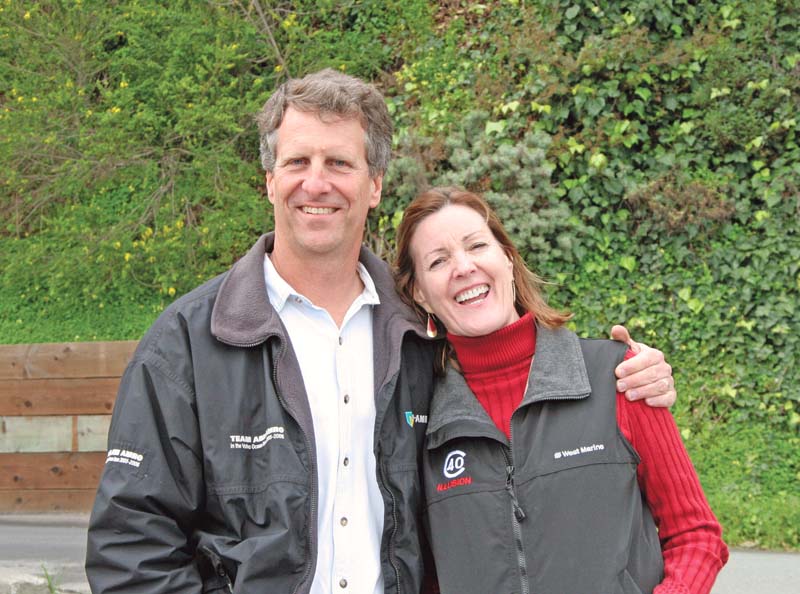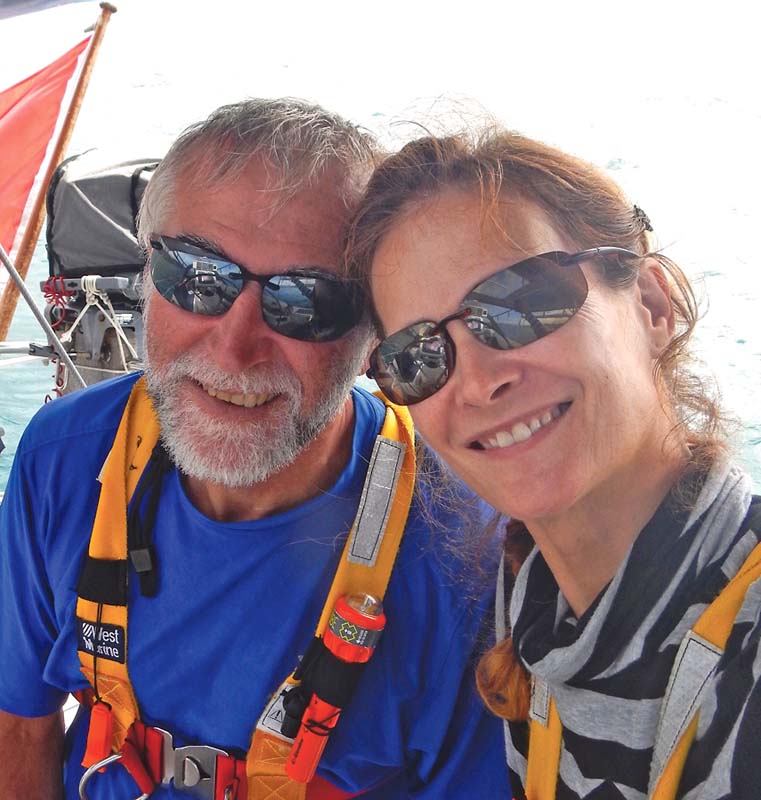
Update on the Demise of ‘Aequus’
On Friday we shared the story of S/V Aequus, the sailboat that ran aground in Paradise Cove, Malibu, on July 4. At that time it appeared the beautiful vessel was lost to the shore. Not so. A team of rescuers from TowBoatUS managed to salvage Aequus and tow her to Marina del Rey. The team then shared the following photos and information on the TowBoatUS Ventura & Channel Islands Facebook page:
“Early Sunday morning, this 58-ft sailboat went aground after having an anchor failure in Paradise Cove, Malibu. Upon arrival, the vessel was sitting on a rock reef with evidence of hull damage. The vessel was de-fueled by Patriot Environmental Services and debris was picked up from the beach.”

“Working with the tide cycles and coordinating with all involved parties, her removal was planned for Thursday.”

“At 7 p.m., after careful planning, rigging, and engineering, our plan to float the vessel off the beach came to fruition and the S/V Aequus went for her final sail out to sea and into Marina del Rey for haulout.”

Aequus was hauled out to reveal the full extent of her condition.

A big thank-you and congratulations to the crew at TowBoatUS Ventura & Channel Islands for a safe recovery. And a big thank-you to David Gorney for passing along the update.
We also received this video taken by Josh Kerwien @thequalifiedcaptain for another view of the damage:
Sailing Is Greening the Blue Planet
While we’re waiting to hear when Saudi Arabia will start exporting camels to 116-degree Canada, much of the sailing world continues its drive toward a more sustainable future. We support all the events and organizations that stick their necks out by making a pledge to simply do better. Cruisers have always been aware of the benefits of conservation and a small footprint, but large entities are now looking harder at how to provide the positive impact of events, without negative impacts on the planet.
This is the reason you find multiple-America’s Cup winner and SailGP founder Russell Coutts standing out in the woods in Italy. SailGP has made a commitment to sustainability and claims it is now a “climate-positive sport, delivering more positive impact than its footprint and focusing on the local community engagement through collaborating with host cities to support projects focusing on social and environmental sustainability.”
This isn’t easy, and deserves the support and appreciation of all sailors. The nature of all events is to provide fun and entertainment for large groups of people, but along with that comes a large carbon footprint. SailGP has made a huge commitment to rebalancing that equation in favor of the planet.

Fortunately, it’s not just SailGP that’s striving to green our blue planet. 11th Hour Racing is another organization working hard to transform events and all of our relationships with the planet through sustainable sailing initiatives. They are the prime supporter of Charlie Enright and Mark Towill’s entry, 1 Degree, in The Ocean Race. The 1 Degree campaign is also committed to sustainability as a foundational principle of their campaign. To help all of us do better at home with our own organizations, 11th Hour Racing is sharing what they’re learning with a Sustainability Toolbox.

On the local level, Sailors for the Sea is here to help us all green our events with their Clean Regattas Program, which provides concrete steps individual event producers can take to help regional events green their blue events by reducing negative impact on the oceans.
The sailing industry also continues to evolve toward more sustainable business practices. Sailcloth manufacturer Dimension Polyant has transformed their two manufacturing plants to being climate neutral since the beginning of 2021.
While we’re thinking globally, here’s a chance to act locally: The Salmon Protection and Watershed Network (SPAWN) needs help restoring habitat on the Lagunitas Creek watershed, the most important habitat for recovering endangered coho salmon on the central California coast. The volunteer event is this Saturday, July 17, from 10 a.m. to 2 p.m. to remove invasive plants at the Tocaloma restoration project site, located at 9255 Sir Francis Drake Blvd. Activities include pulling and cutting back invasive plants such as wild mustard, hemlock, and thistles on the site. You can RSVP here: www.seaturtles.org/events. For an excellent (and comprehensive) article on the oceans and overfishing read here.
It can be easy to be cynical when large events promise to have a light footprint, but we avoid casting stones inside our glass house. We do feel the world would be a better place if everyone lived like sailors. However, when we put on our quick-dry, high-tech plastic sailing clothes, drive down to the sailboat, fire up the diesel to get to the Bay, pull on the plastic lines to haul up our plastic sails to do some low-impact sailing on our plastic sailboat, we recognize we are part of the problem and can do more to be part of the solution. We could throw darts at these grand efforts by large organizations, or applaud their initiative and get on board to see what we can do to green our own sailing while supporting those who boldly make commitments and lead the way. We choose the latter by supporting all sailors helping to green our blue planet.
Dump at the Pump with Division of Boating and Waterways’ ‘Pumpout Nav’ App
Division of Boating and Waterway’s “Pumpout Nav” is a free iOS and Android mobile app that shows you where the nearest sewage pumpout, dump station and floating restrooms are located.
Where Are They Now? Cruise Notes from ‘Changes in Latitudes’
After a long year, more and more cruisers are finally starting to up-anchor again to go cruising. Not that our Changes in Latitudes section had to go dormant; many cruisers found interesting new angles on sailing during the pandemic. And it’s not over yet! Roving reporter Andy Turpin notes that in Tahiti, the anchorages of the French Polynesian islands remain full of cruisers waiting for the islands to the west to open up and allow them to start moving again.
In the July issue of Latitude 38, we have updates from those who are reuniting with their boats both in our Sightings section, and in Cruise Notes within the Changes section.
As we approach the fall cruising season, Sally-Christine Rodgers and Randy Repass let readers of Changes know that their Wylie 65 Convergence is ready and waiting to cruise this year. She’s back on the West Coast after starting her 17-year circumnavigation last fall.

Stan Honey and Sally Lindsay were all set to do the 2020 Bermuda Race when the global pandemic intervened. They’re shifting back to cruising mode for this summer and will be taking their Cal 40 Illusion back to the coast of Maine.

Other cruisers returning after a long absence from their boat are Kim MacLean and Tom Christensen, rejoining their Wauquiez PS40 Exit Strategy. The couple left the boat in Grenada last year when they flew home to Victoria, BC, to ride out the pandemic. They’re planning to return in the fall and continue on toward Panama.

Though it feels as if we’re still a ways off from whatever the ‘new normal’ is going to look like, many cruisers are planning to cautiously set a course toward the old normal and start cruising again. The 140+ boats signed up for the 2021 Baja Ha-Ha are a testament to that. Check out Cruise Notes in our July Changes to see who’s planning to set sail. Or email us with your updated and adjusted cruising plans for 2021/22 here: [email protected].
Celebrate Shark Week with a World Premiere Film from Mexico
This week is officially Shark Week — July 11 to 18. Perhaps you already know about Shark Week and what it means to us, and of course to the sharks. However, if you’re like this writer, you might have to look it up to find out what the excitement is about. We’ve saved you the trouble, and here is what we’ve learned.
Shark Week originated in 1988 as a week-long period during which television programming focused on sharks. According to Wikipedia (our go-to resource for all things obscure), Shark Week was “originally devoted to conservation efforts and correcting misconceptions about sharks.” Over the ensuing years it gained popularity and became an annual feature on the Discovery Channel. Furthermore, it now holds the honor of being the “longest-running cable television programming event in history.”
And that’s not all. Shark Week has become a much-promoted event on social media and subscription-based movie and televisions services. This coincides with skepticism and criticism of the week’s programming, which also carries much fictional and entertainment-oriented material such as Megalodon: The Monster Shark Lives and Shark of Darkness: Wrath of Submarine. Apparently the word for this type of program is ‘docufiction’: a cinematographic combination of documentary and fiction.
But fortunately there are still many genuine and quality shark-related documentaries aired during Shark Week. Details of one such film were sent to us by the organizers of the International Ocean Film Festival (IOFF).

Sharks of the Sea of Cortés: A Lost Treasure? directed by James Ketchum, is making its world premiere this week. The 26-minute-long film captures the work between scientists and fishermen to restore and protect sharks and their marine ecosystems in Baja California. And as these waters are part of our sailing grounds, we wanted to share the opportunity to view this film.
Tickets are $10 and are available here, along with a trailer of the film. We hope you enjoy it!

